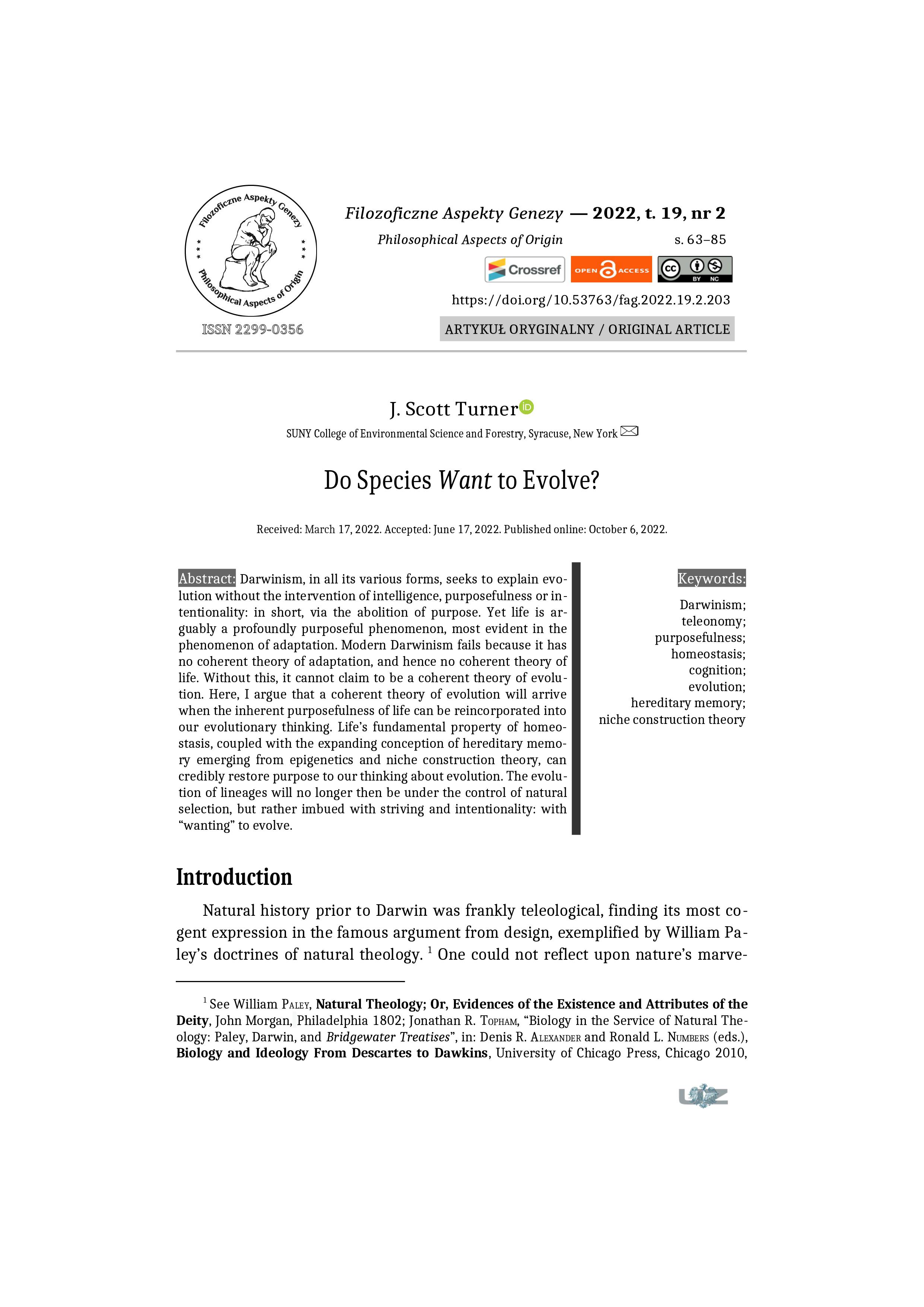
Opublikowane 06.10.2022 — zaktualizowane 21.12.2022
Wersje
- 21.12.2022 - (2)
- 06.10.2022 - (1)
Słowa kluczowe
- Darwinism,
- teleonomy,
- purposefulness,
- homeostasis,
- cognition
- evolution,
- hereditary memory,
- niche construction theory ...More
Prawa autorskie (c) 2022 Filozoficzne Aspekty Genezy

Utwór dostępny jest na licencji Creative Commons Uznanie autorstwa – Użycie niekomercyjne 4.0 Międzynarodowe.
Jak cytować
Abstrakt
Darwinism, in all its various forms, seeks to explain evolution without the intervention of intelligence, purposefulness or intentionality: in short, via the abolition of purpose. Yet life is arguably a profoundly purposeful phenomenon, most evident in the phenomenon of adaptation. Modern Darwinism fails because it has no coherent theory of adaptation, and hence no coherent theory of life. Without this, it cannot claim to be a coherent theory of evolution. Here, I argue that a coherent theory of evolution will arrive when the inherent purposefulness of life can be reincorporated into our evolutionary thinking. Life’s fundamental property of homeostasis, coupled with the expanding conception of hereditary memory emerging from epigenetics and niche construction theory, can credibly restore purpose to our thinking about evolution. The evolution of lineages will no longer then be under the control of natural selection, but rather imbued with striving and intentionality: with “wanting” to evolve.
Downloads
Bibliografia
- Alexander Denis R. and Numbers Ronald L. (eds.), Biology and Ideology From Descartes to Dawkins, University of Chicago Press, Chicago 2010.
- Amadio Anselm H. and Minio-Paluello Lorenzo, Aristotle and Aristotelianism, Encyclopædia Britannica 1994, Vol. 14, pp. 55–71.
- Ayala Francisco J., Teleological Explanation in Evolutionary Biology, Philosophy of Science 1970, Vol. 37, No. 1, pp. 1–15.
- Batra Lekh R. (ed.), Insect-Fungus Symbiosis: Nutrition, Mutualism and Commensalism, John Wiley and Sons, New York 1979.
- Batra Lekh R. and Batra Susane W.T., Termite-fungus Mutualism, in: Batra (ed.), Insect-fungus Symbiosisq…, pp. 117–163.
- Baylin Stephen B. and Schnabel Kornel E., The Epigenomic Era Opens, Nature 2007, Vol. 448, No. 7153, pp. 548–549.
- Bernard Claude, An Introduction to the Study of Experimental Medicine, trans. Henry Copley Greene, Classics of Medicine Library, Henry Schumann Inc., 1927.
- Bowler Peter J., The Eclipse of Darwinism: Anti-Darwinian Evolution Theories in the Decades around 1900, Johns Hopkins University Press, Baltimore — London 1983.
- Boyer Philippe, Action de certains termites constructeurs sur l’évolution des sols tropicaux I. Les termites et le sol, Annales des Sciences Naturelles Zoologie Paris 12 série 1973, Tome 15, Numero 3, pp. 329–498.
- Boyer Philippe, Etude particulière de trois termitières de Bellicositermes et de leur action sur les sols tropicaux, Annales des Sciences Naturelles (Zoologie et Biologie Animale) 1975, Tome 17, Numero 3, pp. 273–446.
- Boyer Philippe, Differents aspects de l’action des termites sur les tropicaux, in: Pesson (ed.), La vie dans les sols…, pp. 279–334.
- Boyer Philippe, Les différents aspects de l’action des Bellicositermes sur les sols tropicaux, Annales des Sciences Naturelles (Zoologie et Biologie Animale) 1975, Tome 17, Numero 4, pp. 447–504.
- Boyer Philippe, Les effets de l’implantation destermitières des Bellicositermes sur la configuration des sols des savanes de la République centrafricaine, Bulletin de Muséum National d’Histoire Naturelle 1969, 2e Série, Tome 41, No 3, pp. 789–800.
- Brauman Alain, Kane Matthew D., Labat Marc, and Breznak John A., Genesis of Acetate and Methane by Gut Bacteria of Nutritionally Diverse Termites, Science 1992, Vol. 257, No. 5075, pp. 1384–1387.
- Calovi Daniel S., Bardunia Paul, Carey Nicole, Turner J. Scott, Nagpal Radhika, and Werfel Justin, Surface Curvature Guides Early Construction Activity in Mound-building Termites, Philosophical Transactions of the Royal Society B: Biological Sciences 2019, Vol. 374, No. 1774, article number: 20180374, https://doi.org/10.1098/rstb.2018.0374.
- King-Hele Desmond (ed.), Charles Darwin’s The Life of Erasmus Darwin, Cambridge University Press, New York 2003.
- Darwin Francis (ed.), Charles Darwin: His Life Told in an Autobiographical Chapter and in a Selected Series of His Published Letters, D. Appleton and Company, New York 1893.
- Darwin Charles, On the Origin of Species by Means of Natural Selection, or the Preservation of Favoured Races in the Struggle for Life, P.F. Collier & Son, New York 1909.
- Darwin Charles, The Variation of Animals and Plants Under Domestication, John Murray, London 1868.
- Darwin Erasmus, Zoonomia; Or, The Laws of Organic Life. In Three Parts, Thomas & Andrews, Boston 1809.
- Darwin Erasmus, The Loves of the Plants, J. Johnson, London 1806.
- Dennett Daniel C., Darwin’s Dangerous Idea: Evolution and the Meanings of Life, Simon & Schuster, New York 1996.
- Deshmukh Ian, How Important are Termites in the Production Ecology of African Savannas?, Sociobiology 1989, Vol. 15, No. 2, pp. 155–168.
- D’Odorico Paolo and Porporato Amilcare (eds.), Dryland Ecohydrology, Springer, Dord-recht 2006.
- Felsenfeld Gary, A Brief History of Epigenetics, Cold Spring Harbor Perspectives in Biology 2014,Vol. 6, No. 1, article number: a018200, https://doi.org/10.1101/cshperspect. a018200.
- Fisher Ronald A. (ed.), The Genetical Theory of Natural Selection: A Complete Variorum Edition, Oxford Universisty Press, Oxford — New York 1999.
- Green Ben, Bardunias Paul, Turner J. Scott, Nagpal Radhika, and Werfel Justin, Excavation and Aggregation as Organizing Factors in de novo Construction by Mound-Building Termites, Proceedings of the Royal Society B: Biological Sciences 2017, Vol. 284, No. 1856, article number: 20162730, https://doi.org/10.1098/rspb.2016.2730.
- Gross Charles G., Claude Bernard and the Constancy of the Internal Environment, The Neuroscientist 2008, Vol. 4, No. 5, pp. 380–385.
- Jablonka Eva and Lamb Marion J., Epigenetic Inheritance in Evolution, Journal of Evolutionary Biology 1998, Vol. 11, No. 2, pp. 159–183.
- Jablonka Eva and Lamb Marion J., Evolution in Four Dimensions: Genetic, Epigenetic, Behavioral and Symbolic Variation in the History of Life, Life And Mind: Philosophical Issues in Biology And Philosophy Series, The MIT Press, Cambridge 2005.
- Lebrun Jean-Claude, Une construction originale hypogée pour le stockage de l’eau par les termites en régions sahelo-soudaniennes de Haute-Volta, Pedobiologia 1976, Bd. 16, Heft 6, pp. 451–456.
- Lepage Michel, Recherches écologiques sur une savane sahélienne du Ferlo septentrional, Sénégal: influence de la séecheresse sur le peuplement en termites, La Terre et la Vie: Revue d’Ecologie Appliquée 1974, Tome 28, Numero 1, pp. 76–94.
- Loison Laurent, Epigenetic Inheritance and Evolution: Historian’s Perspective, Philosophical Transactions of the Royal Society B: Biological Sciences 2021, Vol. 376, No. 1826, article number: 20200120, https://doi.org/10.1098/rstb.2020.0120.
- Marchal Rémy, Chicheportiche Alexandra, Dutrillaux Bernard, and Bernardino-Sgherri Jacqueline, DNA Methylation in Mouse Gametogenesis, Cytogenetic and Genome Research 2004, Vol. 105, No. 2–4, pp. 316–324.
- Mayr Ernst, The Growth of Biological Thought: Diversity, Evolution, and Inheritance, The Belknap Press of Harvard University Press, Cambridge — London 1982.
- Mayr Ernst, Weismann and Evolution, Journal of the History of Biology 1985, Vol. 18, No. 3, pp. 295–329, https://doi.org/10.1007/BF00138928.
- McComas William F., Darwin’s Invention: Inheritance & the «Mad Dream» of Pangenesis, The American Biology Teacher 2012, Vol. 74, No. 2, pp. 86–91, https://doi.org/10.1525/abt.2012.74.2.5.
- Noble Denis, Evolution Viewed from Physics, Physiology and Medicine, Interface Focus 2017, Vol. 7, No. 5, https://doi.org/10.1098/rsfs.2016.0159.
- Oldroyd Benjamin P. and Yagound Boris, The Role of Epigenetics, Particularly DNA Methylation, in the Evolution of Caste in Insect Societies, Philosophical Transactions of the Royal Society B: Biological Sciences 2021, Vol. 376, No. 1826, article number: 20200115, https://doi.org/10.1098/rstb.2020.0115.
- Paley William, Natural Theology; Or, Evidences of the Existence and Attributes of the Deity, John Morgan, Philadelphia 1802.
- Pesson Paul (ed.), La vie dans les sols. Aspects nouveaux. Etudes expérimentales, Gauthier Villars, Paris 1971.
- Pigliucci Massimo, Do We Need an Extended Evolutionary Synthesis?, Evolution 2007, Vol. 61, No. 12, pp. 2743–2749.
- Pittendrigh Colin S., Adaptation, Natural Selection and Behavior, in: Roe and Simpson (eds.), Behavior and Evolution…, pp. 390–416.
- Provine William B., The R.A. Fisher — Sewall Wright Controversy in: Sarkar (ed.), Boston Studies in the Philosophy…, pp. 201–229.
- Riskin Jessica, The Restless Clock: A History of the Centuries-Long Argument Over What Makes Living Things Tick, The University of Chicago Press, Chicago — London 2016.
- Roe Anne and Simpson George Gaylord (eds.), Behavior and Evolution, Yale University Press, New Haven 1958.
- Sarkar Sahotra (ed.), Boston Studies in the Philosophy of Science, Vol. 142, Kluwer Academic Publishers, Boston 1992.
- Topham Jonathan R., Biology in the Service of Natural Theology: Paley, Darwin, and Bridgewater Treatises, in: Aleksander and Numbers (eds.), Biology and Ideology From Descartes…, pp. 88–113.
- Turner J. Scott, Homeostasis, Complexity and the Problem of Biological Design, Emergence, Complexity and Organization 2008, Vol. 10, No. 2, https://tiny.pl/wg4cr [14.09.2022].
- Turner Scott J., Many Little Lives, Inference: International Review of Science 2018, Vol. 4, No. 1, https://www.doi.org/10.37282/991819.18.16.
- Turner J. Scott, Purpose and Desire: What Makes Something Alive and Why Modern Darwinism Has Failed to Explain It, HarperOne, San Francisco 2017.
- Turner J. Scott, Semiotics of a Superorganism, Biosemiotics 2016, Vol. 9, No. 1, pp. 85–102, https:/doi.org/10.1007/s12304-016-9256-5.
- Turner J. Scott, Termites as Mediators of the Water Economy of Arid Savanna Ecosystems, in: D’Odorico and Porporato (eds.), Dryland Ecohydrology…, pp. 303–313.
- Turner J. Scott, Termites as Models of Swarm Cognition, Swarm Intelligence 2011, Vol. 5, No. 1, pp. 19–43, https://doi.org/10.1007/s11721-010-0049-1.
- Turner J. Scott, The Extended Organism: The Physiology of Animal-Built Structures, Harvard University Press, Cambridge 2000.
- Turner J. Scott, The Tinkerer’s Accomplice: How Design Emerges from Life Itself, Harvard University Press, Cambridge — London 2007.
- Turner J. Scott, Marais Eugene, Vinte Mendes, Mudengi Angela, and Park Wendy, Termites, Water and Soils, Agricola 2006, Vol. 16, pp. 40–45.
- Ward Peter, Lamarck’s Revenge: How Epigenetics Is Revolutionizing Our Understanding of Evolution’s Past and Present, Bloomsbury Publishing, New York — London — Oxford — New Delhi — Sydney 2018.
- Watson Jean-Paul, Calcium Carbonate in Termite Mounds, Nature 1974, Vol. 247, No. 5435, pp. 74.
- Weismann August, The Germ Plasm: A Theory of Heredity, trans. W. Newton Parker and Harriett Röunfeldt, The Contemporary Science Series, Walter Scott Limited, London 1893.
- Wolfe Charles T., From Substantival to Functional Vita lism and Beyond: Animas, Organisms and Attitudes, Eidos 2011, Vol. 14, pp. 212–235.
- Wolfe Charles T., Introduction. Vitalism without Metaphysics? Medical Vitalism in the Enlightenment, Science in Context 2008, Vol. 21, No. 4, pp. 461–463.
- Wolfe Charles T. and Terada Motoichi, The Animal Economy as Object and Program in Montpellier Vitalism, Science in Context 2008, Vol. 21, No. 4, pp. 537–579.


